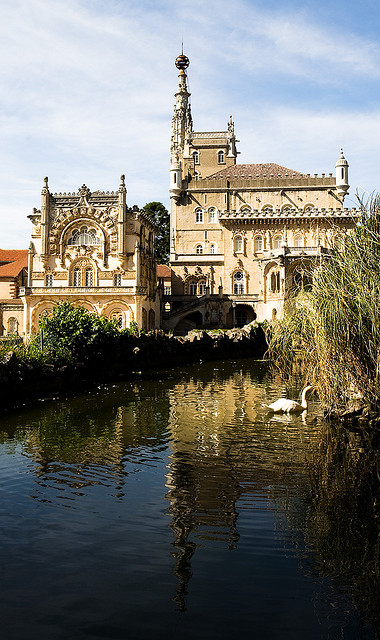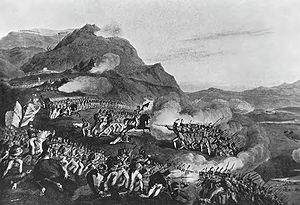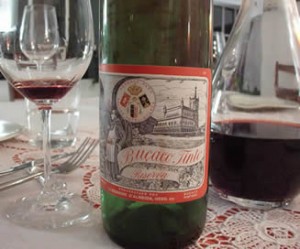PALACE HOTEL AT BUSACCO
My wife, Barbara, and I were driving around Portugal on a route created by putting red dots on a road map at locations of interesting wineries, and then connecting them via various other places of interest. Our friend Tim had bootstrapped this process with some helpful maps and suggestions, from his travels there.
When we drove into sight of the great old Palace Hotel do Bucaco (alternatively spelled and pronounced Busacco and Bussaco), we knew we were doing something right. This fabulous old building, with its lavish Manueline architecture, was once a hunting lodge for Portuguese royalty, and was obviously waiting for us.
The hotel, with its vineyards and wine operations, sits astride two premier Portuguese wine districts: the Barraida and the Dao. Happily the Busacco wine manages to capture the fine characteristics of both. And the hotel restaurant is excellent, as well.
We found that the hotel made wine in the traditional way: grapes actually crushed by foot in lagars or vats, with the wine aged for years in the cellar. It’s generally only available at the hotel, but I notice that a little has made it out and is available on the web – maybe thanks to guests.
Busacco also has an interesting military history. The place is famous for, yes, the Battle of Busacco, which took place nearby the hotel on Busacco Ridge in 1810.
British and Portuguese forces under Wellington were in the area, and Napoleon had commanded his Marshal Massena to run the English out of Portugal. Massena, with 65,000 French troops went up against Wellington, with a combined British/Portuguese force of 50,000. But the wily Wellington had prepared well.
He hid the location of his troops behind the ridge, which made it difficult for the French to determine just where and how many there were, and made trying to soften them up with artillery before the attack ineffective. Wellington also had a roadway built behind the ridge, allowing rapid and unseen concentration of troops against enemy weak points, creating significant mismatches.
To Napolean’s great consternation, Wellington was able to turn the tables and drive the French out of Portugal. This was the beginning of the end for Napoleon on the Iberian Peninsula. There’s a good museum near the hotel, with armaments, uniforms, etc. from the time.
Back at the hotel, a found strategy …
I tend to write about devising strategies. But sometimes it’s possible (and altogether reasonable) to just stumble onto a good one, and build on it. That’s what the people running the hotel had done long ago. And, in turn, Barbara and I stumbled onto theirs.
How do you detect a strategy in operation? You sniff it out. In this case, it was the smell of winemaking.
We came out of our room on the upper floor of the hotel, down the ornate hallway, and into the elevator. Pressed the “down” button. As the elevator began to descend, the cab filled with an extraordinary aroma, the unmistakable smell of wine in the making, the air charged with plenty of alcohol.
After the short time taken to reach the main floor, we came reeling out of the elevator, wanting nothing other than a bottle of their fine wine and a good meal to go with it. We headed straight for the restaurant.
Now this was great marketing strategy in action. And it wasn’t a systematically devised strategy.
It was the artifact of building the elevator over the wine cellar below. The elevator, open to the cellar, acted as an air pump. As the elevator moved up to the guest rooms above, the cab acted like a piston, pulling cellar air up with it. Then when it moved down, the heady air filled the cab through vents.
Within a few floors, no one feels any pain, and is ready for some of the great stuff they’re breathing. While not an intentional strategy for creating demand for their wine, once in place, the management built on it with strategically placed wine pictures and bottles, drawing guests to the restaurant.
Finding strategies
The hotel wine marketing strategy was an unintended consequence of an elevator engineering strategy. No one had to think it up. It was just sitting there for the taking, and it works just fine, thanks. But who knew? No one. It was hidden until it was discovered.
So in addition to devising our own strategies, another source is to find them. But how do we go about finding strategies?
As pointed out in Strategy Facts of Life, they’re everywhere around us. Everywhere. All organisms embody strategies for reproduction, geographic propagation, obtaining food, obtaining water, defending themselves, etc. And they’ve been generating strategies since the beginning of life, so some of them are pretty good, you might say.
Many of these strategies can be seen in the behaviors of plants and animals, for example the circling of yaks when wolves come near. Many can be seen in the artifacts they leave behind, such as sea shells – or in the case of man, arrowheads, e.g. These are all clues as to strategies being followed, and can suggest strategies we, ourselves, could adopt in circumstances with similar characteristics.
Functional designs also embody strategies. They have objectives, barriers that they overcome using vulnerabilities that can be exploited by advantages in resources, etc. – the usual elements of a strategy. The commercial use of these designs/strategies is often protected by law: patents.
But by no means in all cases. Drug companies send people into remote jungle locations to spend time with tribes and re-find strategies that the native people themselves have found and use for medicinal purposes. Usually in the form of an exotic herb or drug that the company can chemically copy.
The drug companies, like the hotel management, can take the found strategy and enhance it with their own finishing touches. Cheaper than drug research – and with proven results! Did I mention that the tribes hadn’t already filed patent applications for the cures? Evidently in some cases at least, the drug companies compensate the tribes.
The drug company case is interesting because, unlike the hotel management, they systematically prospect for hidden strategies. There’s something to be learned from how they go about it.
They target remote areas with high biological diversity to increase chances of encountering previously undiscovered cures. They send observant, well-trained scientists into these areas to spend time with native tribes to observe their health conditions and how they treat ailments, wounds, etc.
When they find a candidate cure of interest, they learn about what goes into the medicine, how it’s collected, how it’s processed, how it’s administered to the patient, etc. All this information, as well as samples, is taken back to the company. If prospects look good, the cure is subjected to the same kind of testing and evaluation as one originating in the laboratory.
If the test results are positive, the “jungle” methods of obtaining the active ingredients and processing them are translated into modern industrial processes.
So the method of strategy prospecting is pretty straightforward. Say you’re a competitor or coach, the strategies in your sport are well-known and have been adopted by all your competitors, and the strategies no longer offer much advantage. How to come up with one that can separate you from the competition?
Either devise or find. In this case you feel finding is the better choice. So you crank up the gain on your attention and start watching other sports that have some characteristics similar to your own. You’re trying to perceive what it is that is making competitors in that sport successful – that is different from your own sport.
When a good prospect is found, it’s translated into technique and action in your own sport, tried out and evaluated. If it looks good, training based on it follows and it’s introduced into actual competition.
A parallel approach can be used in any field. It all starts with attention.
Attention to what? Well, whatever’s there. Not only in finding strategies, but also in devising them, it’s rare that the situation initially seems obvious. We often sense something about them immediately, intuitively. But we generally need some time for exploration and for sorting things out before we have a real handle on them. We need to give a clear perception of the situation time to emerge from what’s fair to call “The Gray Area” – the topic of our next post.
______________________________________________________________________________
Readers are encouraged to add comments to this post.
And if you’d like to share or recommend the post, click on your preferred way in the left margin sidebar.
If you’re not currently being automatically notified when new posts are published, then please Follow Real Strategy (top of right hand column on this page), and indicate how you’d prefer to be notified.
For other posts of interest, look in the Smart Menu.
Photo credit: Palace Hotel do Bucaco, by Danielle Parker; see her photo stream at www.flickr.com/photos/daniellepalmer/3613484565/, and her website at www.daniellepalmer.co.nz
Image credit: Battle of Busacco, from Wikipedia, http://en.wikipedia.org/wiki/Battle_of_Bussaco,
Photo credit: Bucaco Tinto Reservada, by Jamie Goode; see his online wine magazine at http://www.wineanorak.com/weekend_porto4.htm









Bill,
Thanks for the thoughtful approach to strategic decision making. Your approach is elegant in its simplicity and useful daily as it honors George Miller’s Magic number: 5 plus or minus 2. At 6, you are pretty much in everyone’s wheelhouse. We can handle it.
Drill down beneath the 6 steps and you will find strategic, operational, logistical and tactical elements, in that order. It may be useful to examine the complexity that is contained beneath the simplicity. I broke down the escape from East Berlin example into those four elements using a decision tree analysis. Interested in your thoughts.
See you Tuesday, Bill.
[Translate]
Interesting comments, Joe. Funny you should mention Miller’s limit. When I was working through the general problem of modelling any strategy, keeping the no. of elements manageable was very important to me. I tried a lot of restructuring to get it down to 5, but the truth just wasn’t in that number. 6 is a stretch for many people, so I decided to structure them into the 3 problem/opportunity/solution pairs, which are readily decomposable.
I hadn’t been thinking of the mil/supply chain management dimension you indicate. I’d like to go through that with you and see what you did. Coffee sometime, OK?
[Translate]
Bill, My age is showing. George Miller’s magic number is actually 7 plus or minus 2, so 6 still works. Joe Miller’s magic number is clearly reduced to 5 and counting.
Sherman’s strategy was divide and conquer. The German escape strategy was frontal attack. (Hogan’s Heros would have used a strategy of deception, perhaps using Colonel Clink’s official car to drive past a saluting border guard.) The remainder is operational planning, logistics and tactics. The human mind often thinks of a viable tactic, then back fills the planning and logistics without clearly defining or even recognizing the true strategy.
Your model is an effective way to organize the process into a simple, one level, linear stream of thought.
Question- Why does the diagram move right to left when we normally read left to right?
[Translate]
I usually prefer indirect strategies to direct ones, too, and would have liked to have told a tale of escape by guile. But Achim gave us a useful example.
And right – the diagram convention could well have gone the other way. In the end, given that the Objectives Diagram needed to go from left to right (precedent in PERTcharts, etc), and that for complex strategies one would be devising substrategies on the left before on the right, the Strategy Diagram would have to end up with the objective on the right as well. So far, no one who speaks Arabic seems to mind going from right to left.
[Translate]